This year Queen Elizabeth II became the first British monarch to celebrate a Platinum Jubilee after 70 years on the throne. Her Majesty is the longest reigning British monarch. The Queen, aged 25, ascended the throne on 6 February 1952 following the death of her father, King George VI.
This blog post focuses on the Queen’s ground-breaking coronation, the first coronation to be televised. The coronation was watched by 27 million people in the UK, as well as millions of others around the world! (see footnote 1) For the first time in history, people on a mass scale could watch the coronation. Drawing upon the records of the Prime Minister’s Office, Home Office, Ministry of Works, Air Ministry, and Cabinet Papers, this blog post explores this momentous occasion in history.
The coronation ceremony took place at Westminster Abbey on 2 June 1953. This photograph shows inside Westminster Abbey, with the coronation chair at the centre.

There was much debate as to whether the coronation should be televised, and if it was, which aspects of the ceremony would be shown on television. Winston Churchill, who was Prime Minister at the time, declared in a speech in October 1952 that:
There is I feel a broad general opinion, in this country at least … that fuller advantage should be taken of modern mechanical arrangements now available through television, to enable the many millions of people outside the Abbey to see what is seen by the congregation of nobles of the Abbey.
Draft speech by the Prime Minister, October 1952, PREM 11/34, The National Archives
Initially, the Coronation Joint Committee (who were responsible for organising the coronation) recommended that ‘television be restricted to parts of the Service west of the Screen.’ (footnote 2) This was partly to ensure that the televised aspects of the ceremony would be confined ‘to the more secular parts of the Service.’ (footnote 3)
However, the Coronation Joint Committee subsequently recommended, with the approval of the Coronation Commission, ‘the extension of television to parts of the Service east of the Screen. It is therefore hoped to make arrangements for the Recognition, the Crowing and the Homage to be included. The Anointing, the Communion Prayers and the Administration of the Sacrament would be excluded.’ (footnote 4)
Cabinet ministers also debated this proposed extension of televising the coronation; this memoranda from October 1952 shows Cabinet Ministers debating the pros and cons.
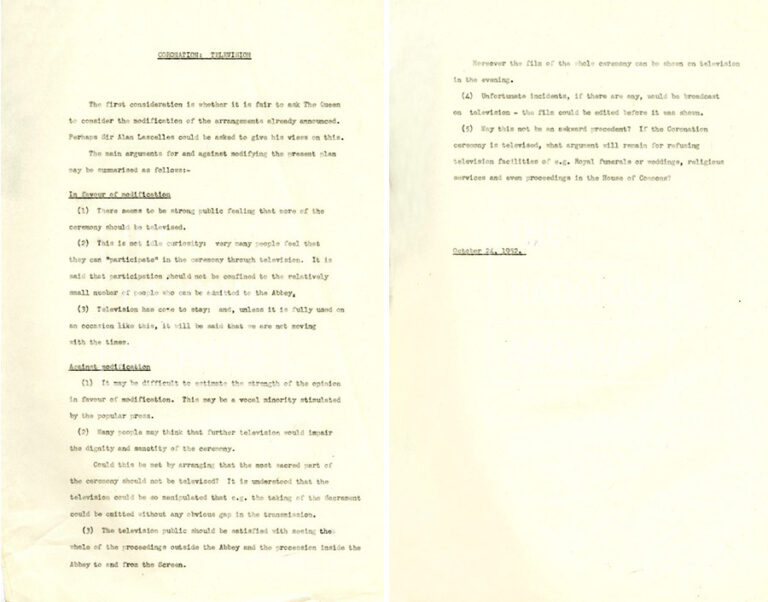
The pros list included that ‘many people feel that they can ‘participate’ in the ceremony through television’ and that ‘television has come to stay’ so they must move with the times (footnote 5).
In contrast, the cons list stated ‘that further television would impair the dignity and sanctity of the ceremony’ and that ‘If the Coronation ceremony is televised, what argument will remain for refusing television facilities of e.g. Royal funerals or weddings, religious services and even proceedings in the House of Commons?’ (footnote 6)
It was subsequently agreed that four main areas would be televised ‘the Queen’s Procession to the Abbey, the Coronation Service, the State Procession and the Queen’s appearance on the balcony at Buckingham Palace.’ (footnote 7) The report went on to state that ‘The B.B.C. have installed special relay stations to carry out the television pictures to France, Holland and Western Germany. This is the first time a live television broadcast has been shared by four different countries.’ (footnote 8)
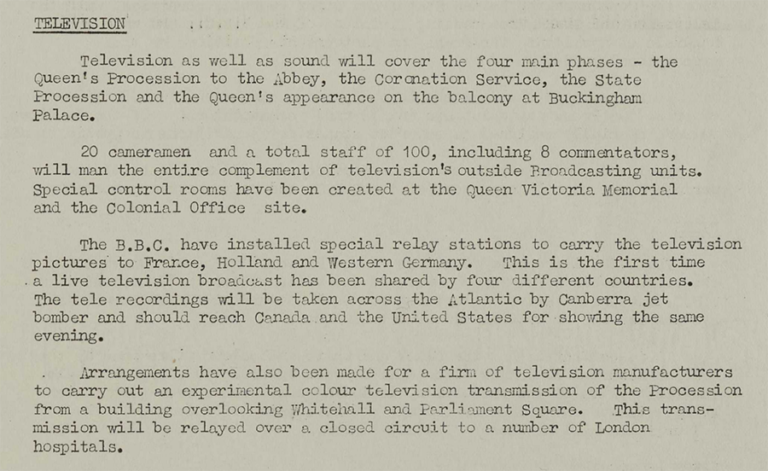
Over 8,000 guests attended the Queen’s coronation ceremony. Among the guests were members of the royal family, heads of state from around the Commonwealth, and politicians. In addition to being televised on the BBC, the coronation was also broadcast on the radio and filmed by newsreel companies. As a result, hundreds of photographers, reporters and camera operators were in attendance at the event.
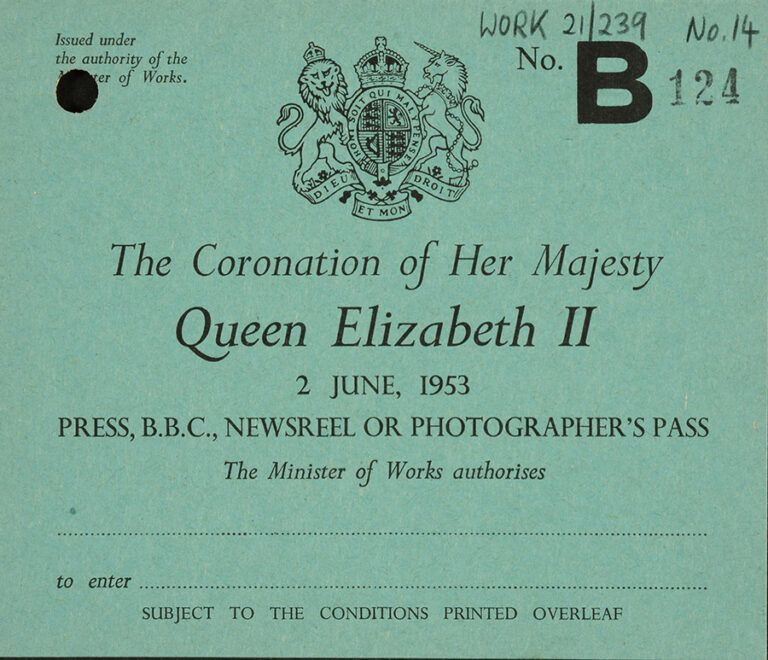
In addition to having cameras inside Westminster Abbey, they were also located along the procession route and by the Queen Victoria Memorial outside Buckingham Palace, as this diagram shows.
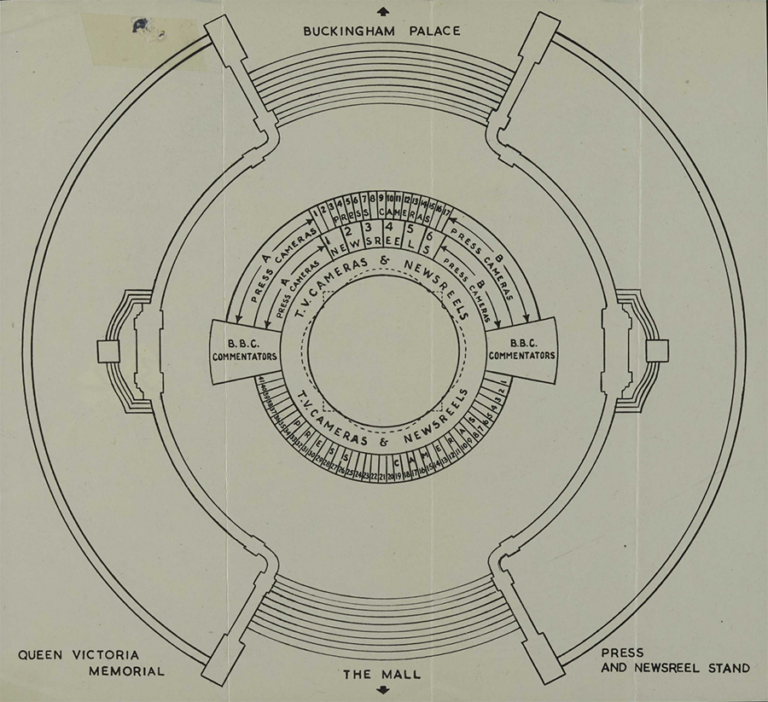
When considering how the televised coronation would look on screen, it was decided that ‘Cameras will be completely concealed’ (footnote 9). No special lighting will be required for television as the lighting for newsreel cameras will be more than enough.’ (footnote 10)
A breakdown of possible (and simplified) camera shots for the ceremony was constructed, totalling 40 seconds of close-ups, 49 minutes of mid-shots, and 1 hour 6 minutes of long shots or symbolic shots (footnote 11).
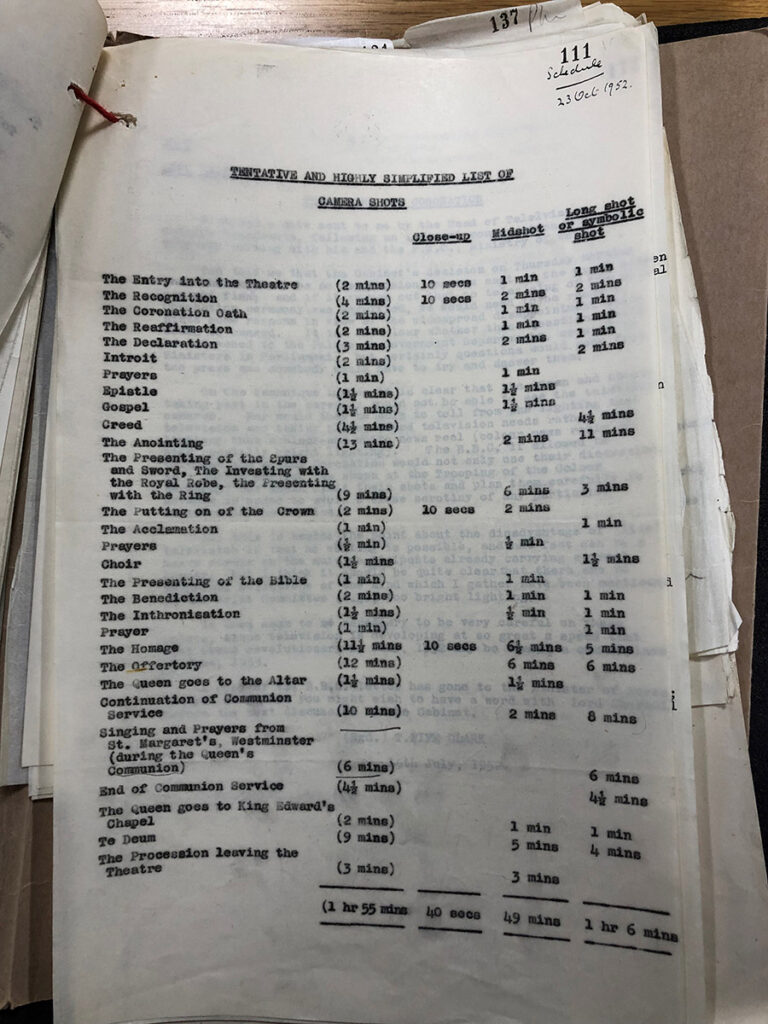
Not everyone had access to a television to watch the coronation and there was a growing demand for public showings of the coronation. A letter from E C Robbins (from the British Broadcasting Corporation) to R J Broadbent (from the Overseas Telecommunicated Department), dated 19 September 1952, stated ‘We are receiving enquires from Town Clerks in various parts of the country in regard to the possibility of giving a public showing of the television Coronation programmes as part of their local celebrations.’ (footnote 12)
Given the special occasion, a collective licence for public showing on Coronation Day was authorised by The Queen’s Postmaster General (footnote 13).
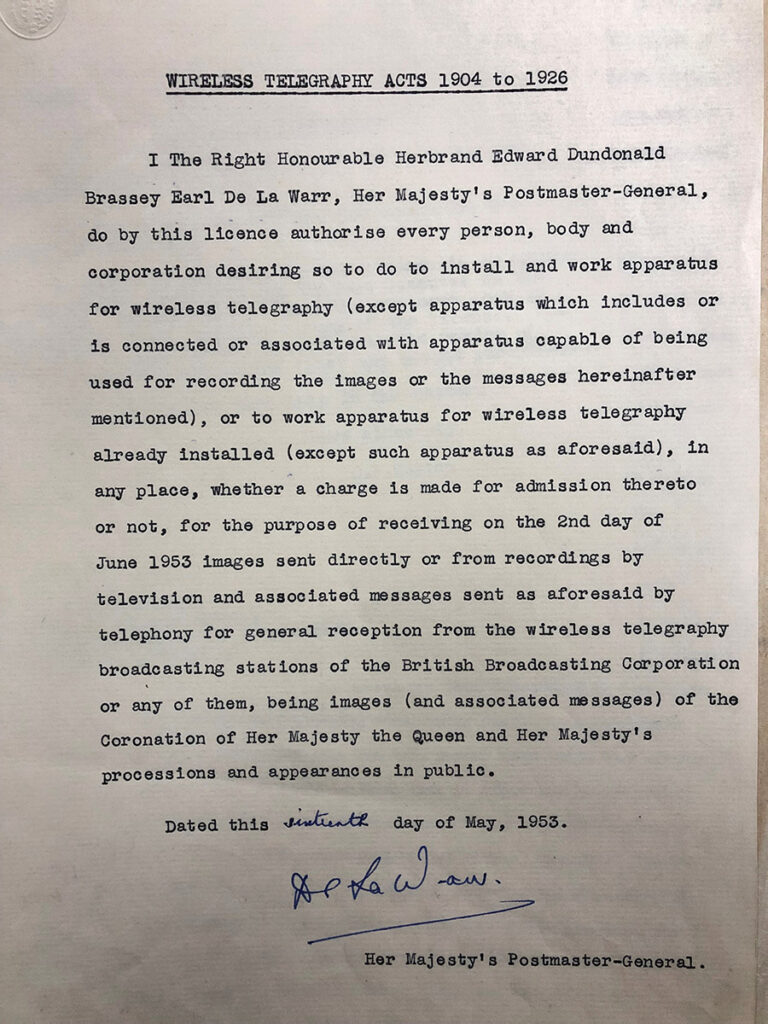
The press showed great interest in the televised coronation. In the lead up to the coronation, The Star ran an article titled ‘Coronation On TV For Ten Hours’ (footnote 14). The article went on to declare that the coverage of the coronation would begin at 10:15 and run through into the evening to capture the London County Council’s firework display (footnote 15).
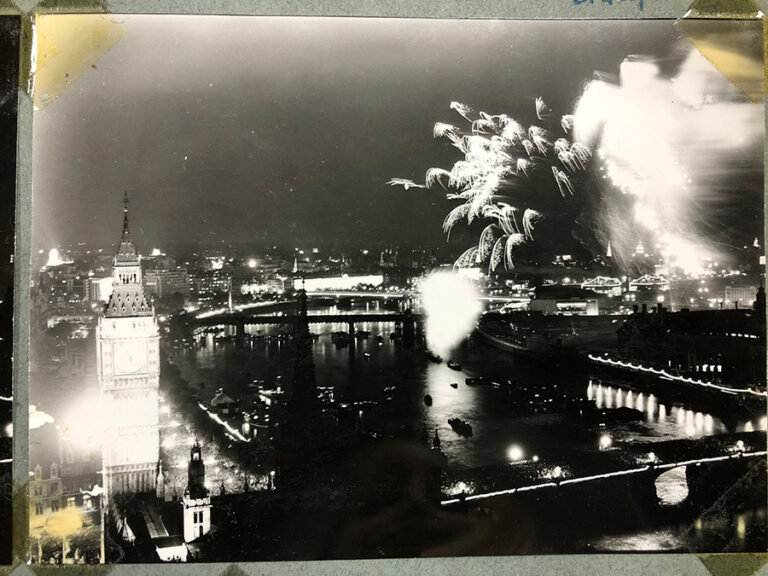
Moreover, records from the Air Ministry show that television recordings of the coronation were flown to both Canada and the United States. A joint press release from the Air Ministry and BBC read:
‘To enable telefilms of the Coronation to be shown on television screens in Canada and the United States during the evening of 2nd June two Royal Air Force Canberra jet aircraft will fly the telefilms across the Atlantic to Canada where Royal Canadian Air Force C.F. 100 jet fighters will be waiting to assist in completing the delivery.’
Joint Air Ministry/BBC press release, 1953, AIR 2/11248, The National Archives
This shows the international interest surrounding the Queen’s coronation and the urgent nature of flying the television recordings across the Atlantic, so they could be watched by the public in Canada and the United States.
The records held at The National Archives provide us with a fascinating insight into the Queen’s coronation – the first to be televised and watched on a mass scale.
Footnotes
- ‘Coronation Day’, Royal Collection Trust, (accessed 20 May 2022).
- Note by the Secretary of the Cabinet on Coronation: Television, 12 November 1952, PREM 11/34, The National Archives.
- Note by the Secretary of the Cabinet on Coronation: Television, 12 November 1952, PREM 11/34, The National Archives.
- Note by the Secretary of the Cabinet on Coronation: Television, 12 November 1952, PREM 11/34, The National Archives.
- Cabinet Office memoranda on televising the coronation, 24 October 1952, CAB 21/3731, The National Archives.
- Cabinet Office memoranda on televising the coronation, 24 October 1952, CAB 21/3731, The National Archives.
- Report on Press, BBC, and Newsreel Facilities, 1953, WORK 21/303, The National Archives.
- Report on Press, BBC, and Newsreel Facilities, 1953, WORK 21/303, The National Archives.
- ‘Suggested Method Of Televising The Coronation Ceremony And Services’, AIR 20/9685, The National Archives.
- ‘Suggested Method Of Televising The Coronation Ceremony And Services’, AIR 20/9685, The National Archives.
- ‘Tentative and Highly Simplified List of Camera Shots’, 23 October 1952, PREM 11/34, The National Archives.
- Letter from E. C. Robbins to R. J. Broadbent, 19 September 1952, HO 256/323, The National Archives.
- Collective licence for public showing on the Queen’s coronation, 16 May 1953, HO 256/323, The National Archives.
- ‘Coronation on TV For Ten Hours’, The Star, 5 May 1953, HO 256/323, The National Archives.
- ‘Coronation on TV For Ten Hours’, The Star, 5 May 1953, HO 256/323, The National Archives.
The 1953 Coronation Service in Westminister Abbey was the first to be televised however, in 1936 the enitre Coronation Procession had been televised from Apsley Gate, at Hyde Park Corner by the first mobile Outside Broadcast unit in the world made by Electric and Musical Industries for the BBC. It had three Emitron cameras, two mounted to give views of the procession as it passed through the gate and one on the pavement to give close up views of the various occupants of the passing coaches etc. in particular of the King and Queen. The pictures were taken by a specially designed cable to Broadcasting House and thence to Alexandra Palace for transmission to viewers in the London area. In addition, there was a ‘standby’ radio link to convey the pictures to the Alexandra Palace transmitter if the cable failed. The broadcast was a great success.
My father, Peter Holland ARIBA, an architect working for the (then) Department of Works was part of the team responsible for staging the 1953 Coronation, He kept a daily diary and here are a few extracts which might be of interest:
Tuesday 21 April I spent a most amusing morning at the Abbey with the BBC. Richard Dimbleby, John Snagge and Howard Marshall fitting the cameramen into their respective boxes for their commentaries.
Monday 4 May Went to the Abbey and had a general look round – much progress since I was there last 10 days ago. Met Richard Dimbleby by chance and fixed final arrangements for his box.
Tuesday 5 May Went to the Abbey at 10.30 – all the camera and news reel people there once more. More difficulties and annoyances. Returned to the office for lunch and was back at the Abbey at 2.30 for meeting on security with the Dean and many others. Gold Staff Officer at the Abbey at 3.30, Met John Snagge about his box for the commentary.
Monday 18 May Went to the Abbey to meet Peter Dimmock of BBC but he did not turn up. Richard Dimbleby gave me tickets for a broadcast show at the Palladium. Watched the rehearsal. Duke of Norfolk & Duchess (stand in for the Queen), Alexander, Cunningham, Portall, Alanbrooke, Duke of Richmond etc. Went again after lunch & watched the next [rehearsal] – very amusing.
There are other interesting entries in the diary, including the use of ‘1,000 Guardsmen’ to test the strength of the stands; also, an encounter with the wife of the Dean (Dr Don) who was determined not to have an emergency exit located in the garden of the Dean’s house. She lost the argument!
Thank you for the memories. I was one of the very fortunate children selected to be guests of the Queen at the coronation (though not actually in the Abbey). Every school in Great Britain was invited to select and send two students to attend. A really great thing for those living far away in Scotland, Ireland etc. I was at the time living in Harringay so didn’t have far to travel. My school selected the Head Girl and a vote was taken by the Form 6 (final year) students and for some surprising reason I was selected. We had to get up very early and walk to Wood Green to travel by red bus to the designated area reserved for us – on the embankment not far from the Abbey. Refreshments for a hot day were provided but it was dull and overcast but this did not dampen our enthusiasm. We had a lot of fun, feeding sweets into the hands of the soldiers lining the road in front of us and waiting for the officer in charge to look the other way so the soldiers could pop the sweet into their mouths! We were kept entertained watching the very many cars and carriages passing by, the most memorable of whom was the very colorful Queen of Tonga. Eventually the golden coach came into view and we all cheered like mad. Then it was time to board the red bus again and return home in time to listen to the end of the ceremony on the radio – no tv for us. I day I have never forgotten.
Now a resident of Brisbane Australia since 1959 it has been wonderful watching all the tv coverage of the Jubilee weekend.
Romantic meeting.
My parents met each other at the Queens Coronation my father was one of the Soldiers lining the roads love to think you gave my Dad sweets.I live in Australia since 1981.